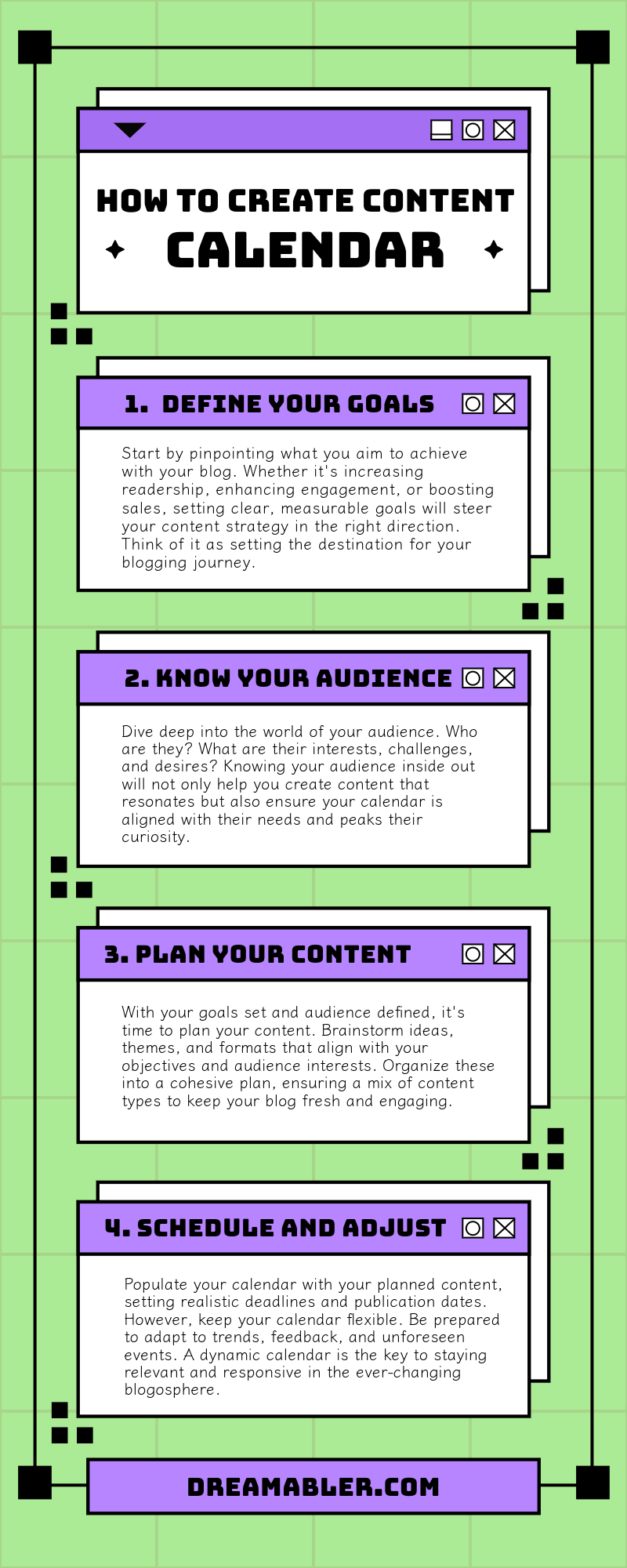Imagine you’re embarking on a cross-country road trip. You wouldn’t just hop in your car and go, would you? No, you’d plan your route, book accommodations, and maybe even pick out a few must-see stops along the way.
This, my fellow bloggers and content creators, is the essence of what a content calendar or editorial calendar brings to your blogging journey.
A content calendar is not just a fancy tool for the uber-organized. It’s your roadmap, your guide, and, dare I say, your blogging bible. It’s what separates the hobbyists from the pro bloggers, the chaotic from the calculated.
But don’t take only my word. According to Copypress, the use of content calendars is widespread among business-to-business companies, with 88% incorporating content marketing into their overall strategy.
Remarkably, those with a developed content marketing plan are 60% more effective than those without one.
But – anyway – why, you ask, do I need this so-called calendar? Let’s dive in.
Elevate Your Blogging Game with a Strategic Content Calendar!
First off, consistency is king in the blogging realm. Your readers are creatures of habit, in some cases even eagerly awaiting your next post like the next episode of their favorite TV show.
A content calendar ensures you’re not leaving them hanging. It’s like promising a weekly dose of your brilliance and actually delivering. Without it, you’re just shooting in the dark, hoping to hit the bullseye.
But it’s not just about churning out content like a factory line. Quality, my friends, is what we’re after. A content calendar allows you to marinate on your ideas, to let them simmer and develop into full-bodied, engaging posts that resonate with your audience.
It’s the difference between a hastily thrown together fast-food meal and a meticulously prepared gourmet feast.
Why Every Blogger Swears by the Magic of Content Calendars
And let’s talk about the dreaded writer’s block. We’ve all been there, staring at a blank screen, the cursor blinking mockingly. With a content calendar, those days are behind you.
By planning ahead, you’re giving your brain a creative roadmap, a jumping-off point. It’s like having a muse on speed dial, ready to inspire at a moment’s notice.
Now, I can hear the naysayers, murmuring about spontaneity and the creative spirit. Fear not, for a content calendar does not shackle your creativity; it liberates it.
Knowing what’s ahead frees you to be in the moment, to adapt and evolve your content as inspiration strikes, without losing sight of the bigger picture.
Maximize Your Blog’s Impact
And here’s the kicker: a content calendar is your secret weapon in the SEO battleground. By strategically planning your content, you can target specific keywords, trends, and themes, making your blog a beacon for search engines and readers alike.
It’s like laying breadcrumbs for Google, leading them straight to your masterpiece.
In the whirlwind world of blogging, where content is king and consistency its queen, a content calendar is your royal advisor, guiding you to reign supreme.
So, take the plunge, embrace the calendar, and watch as your blog transforms from a hidden gem to a shining beacon of digital wisdom.
In a nutshell, a content calendar is not just a tool; it’s a necessity for any blogger serious about their craft. It’s the difference between wandering aimlessly and journeying with purpose. So, why wait? Unlock your blogging success and embrace the content calendar today!
How To Transform Your Blog into a Publishing Powerhouse

Now that we’ve established the monumental importance of a content calendar in your blogging journey, let’s roll up our sleeves and delve into the nitty-gritty of crafting one. This isn’t rocket science, but it does require a dash of dedication and a sprinkle of creativity.
Choose Your Tool
Step one, grab your tool of choice. Whether it’s a good old-fashioned planner, a digital calendar, or a specialized content planning app, the key is finding what resonates with your workflow. Think of it as choosing your weapon before heading into battle.
However, creating a content calendar for your blog can be streamlined with the right tools and apps. Here’s a list of some popular options, each with a brief description to help you choose the best fit for your blogging needs:
- Google Calendar: A versatile, free tool that’s great for beginners. You can create different calendars for various content types and share them with your team.
- Trello: A flexible, card-based system that’s perfect for visual planners. Trello allows you to organize your content ideas on boards, lists, and cards.
- Asana: Ideal for team collaboration, Asana helps you plan and structure your work in a way that’s best for you, with features like tasks, projects, and calendar views.
- Airtable: A mix between a spreadsheet and a database, Airtable allows for a more complex content calendar with custom fields and views.
- CoSchedule: Specifically designed for marketing, CoSchedule offers a unified calendar that integrates social media publishing, projects, and tasks.
- ContentCal: A content planning and automation tool that provides a visual calendar interface, along with analytics and social media integration.
- Hootsuite Planner: Great for managing social media content, Hootsuite Planner allows you to view and edit your social media posts alongside your blog content.
- Evernote: While not a traditional calendar app, Evernote can be used for content planning thanks to its note-taking and organization features.
- Notion: A versatile tool that can be customized for content calendars, among other uses, offering a blend of notes, tasks, databases, and calendars.
- ClickUp: A productivity platform that provides a customizable space for tasks, documents, goals, and calendars, suitable for content planning.
Each of these tools offers unique features and benefits, so consider your specific needs, team size, and workflow preferences when choosing the right one for your blog’s content calendar.
Brainstorming Ideas

Next, it’s time to brainstorm. This is where you unleash your inner creative beast. Jot down every idea, no matter how wild or whimsical. This stage is not about judgment; it’s about liberation. Think of your blog’s themes, upcoming events, or burning questions your audience has.
You’re mining for gold here, and every idea is a potential nugget.
Slotting Ideas Into Your Calendar
Once you have your ideas, start slotting them into your calendar. Consider your publishing frequency – be it daily, weekly, or monthly. Be realistic; it’s better to commit to a schedule you can maintain than to overpromise and underdeliver.
This step is akin to plotting waypoints on a journey, marking where you’ll share your next piece of wisdom with the world.
Now, for each post idea, sketch out a rough outline. What’s the main point? What questions are you answering? What value are you providing to your readers? This outline doesn’t need to be War and Peace; it’s just a beacon to guide you when it’s time to write.
Don’t forget to factor in flexibility. Life happens, trends pop up, and inspiration strikes like lightning. Your content calendar should be a living document, adaptable to the ebb and flow of your creative muse and the world around you.
As you populate your calendar, sprinkle in keywords and SEO strategies like a seasoned chef adding spices to a dish. This is where your content starts to sizzle, attracting both readers and search engines with its irresistible aroma.
And there you have it, a content calendar that’s not just a schedule but a strategic masterpiece, a tapestry of topics that weaves together your blog’s narrative. It’s a commitment to your audience, a promise of quality, and a roadmap to blogging success.
Creating a content calendar might seem daunting at first, but it’s an investment in your blog’s future. It’s the scaffolding upon which you can build a towering structure of engaging, impactful content.
So, take the leap, craft your calendar, and watch as your blog flourishes into a thriving hub of thought leadership and community.
The journey of a thousand posts begins with a single calendar. So, start plotting, start planning, and let the blogging magic unfold.
Infographic

Let’s Share The Blogging Journey!
Why not subscribe to my newsletter? It’s your golden ticket to exclusive insights, tips, and stories that I only share with my newsletter family.
But wait, there’s more! Don’t forget to follow me on my social media channels. It’s where the magic happens daily, and you wouldn’t want to miss out on the fun, would you?
And because the best adventures are shared, I’d love to hear from you. Post your questions, share your comments, and let’s make this journey even more epic together.
FAQ
⭐️What exactly is a content calendar in blogging?
A content calendar in blogging is a strategic scheduling tool that bloggers use to plan, organize, and schedule their content. It outlines when and what content will be published on the blog, helping bloggers maintain a consistent posting schedule, manage themes and topics, and ensure a balanced and diverse content offering to their audience.
⭐️Why is a content calendar important for bloggers?
A content calendar is crucial for bloggers because it helps in maintaining consistency, which is key to building and retaining an audience. It aids in content strategy planning, ensuring a mix of topics and themes that cater to the audience’s interests. Additionally, it allows bloggers to efficiently manage their time and resources, plan for seasonal or trending topics, and track their content’s performance over time.
⭐️How does a content calendar help in managing a blog?
A content calendar helps in managing a blog by providing a clear overview of what content is due to be published and when. This foresight helps in avoiding last-minute rushes, ensuring content quality, and aligning blog posts with marketing goals or significant dates. It also facilitates teamwork by delineating responsibilities and deadlines if multiple contributors are involved in the blog.
⭐️Can a content calendar improve SEO and audience engagement?
Yes, a content calendar can significantly improve SEO and audience engagement. By planning content in advance, bloggers can strategically include keywords, backlinks, and optimize posts for search engines. A well-thought-out calendar ensures regular updates that keep the audience engaged and returning for more. Moreover, it allows bloggers to capitalize on trending topics and seasonal events, further boosting engagement and SEO.
⭐️What tools can be used to create and maintain a content calendar?
There are various tools available for creating and maintaining a content calendar, ranging from simple spreadsheets to specialized software. Popular options include Google Calendar for basic scheduling, Trello and Asana for task management, and CoSchedule or ContentCal for more comprehensive content marketing needs. Each tool offers different features, so the choice depends on the blogger’s specific requirements and workflow preferences.





